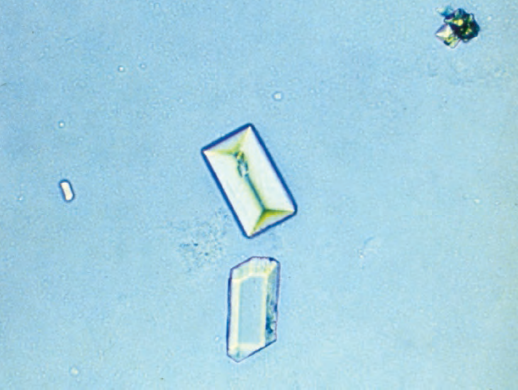ASCPi-URINE AND BODY FLUIDS ANALYSIS
- Description
- Curriculum
- Reviews
-
1HD TUTORIAL - PHYSICAL AND CHEMICAL EXAMINATION OF URINE
-
2PHYSICAL EXAMINATION OF URINE
-
3CHEMICAL EXAMINATION OF URINE
-
4MICROSCOPIC EXAMINATION OF URINE SEDIMENT PART I
-
5RECORDED CLASS- URINE MICROSCOPY I
-
6URINE MICROSCOPY - CELLS
Even though use of brightfield microscopy predominates despite its difficulty in identifying low-refractile entities, phase-contrast microscopy and supravital stains are strongly recommended in the urinalysis testing area.
-
7MICROSCOPIC EXAMINATION OF URINE : CASTS - CRYSTALS
-
8URINE MICROSCOPY - CASTS
Urinary casts are formed in the distal and collecting tubules with a core matrix of uromodulin (formerly known as Tamm-Horsfall protein) that is secreted by the renal tubular cells of the ascending loop of Henle and by the distal convoluted tubules; and its traps and enmeshes formed and chemical element in concentrated urine.
-
9RECORDED CLASS - URINE MICROSCOPY CRYSTALS
Crystals result from the precipitation of urine solutes out of solution. They are not normally present in freshly voided urine but form depending on storage. When are present in freshly voided urine, they are always clinically significant.
Regardless of the crystal type, crystal formation within the nephrons can cause significant tubular damage. Although most crystals are not clinically significant
-
10CEREBROSPINAL FLUID ANALYSIS
CSF bathes the brain and spinal cord, protects and supports the brain and spinal cord and provides a medium for the transport and exchange of nutrients and metabolic wastes.
-
11CEREBROSPINAL FLUID ANALYSIS
As CSF is collected, it is dispensed into three (or more) sequentially labeled sterile collection tubes. The first tube is used for chemical and immunologic testing, the second tube is used for microbial testing, and the third tube is reserved for the microscopic examination of cellular components (i.e., red and white blood cell counts and cytologic studies).
-
12PLEURAL, PERICARDIAL, AND PERITONEAL FLUID ANALYSIS
Normally, serous fluids do not contain blood or fibrinogen, but a traumatic puncture or hemorrhage can result in bloody and clotted fluid
-
13RECORDED LIVE CLASS EFFUSIONS
-
14SYNOVIAL FLUID ANALYSIS
Arthritis and other joint diseases are common, and synovial fluid analysis assists in the diagnosis and classification into one of four categories: noninflammatory, inflammatory, septic, or hemorrhagic.
-
15RECORDED CLASS - SYNOVIAL FLUID ANALYSIS
Arthritis and other joint diseases are common, and synovial fluid analysis assists in the diagnosis and classification into one of four categories: noninflammatory, inflammatory, septic, or hemorrhagic. A definitive diagnosis is possible when microorganisms are identified (septic arthritis) or crystals are present (crystal synovitis) in the synovial fluid.
-
16SEMINAL FLUID ANALYSIS
Seminal fluid, or semen, is a complex body fluid used to transport sperm or spermatozoa. It is analyzed routinely to evaluate infertility and to follow up after a vasectomy to ensure its effectiveness. Other reasons for analysis include the evaluation of semen quality for donation purposes and forensic applications (e.g., DNA analysis, detection of semen).
-
17ANALYSIS OF VAGINAL SECRETIONS
Using a nonlubricated speculum, moistened only with warm water provides access to the vaginal fornices. A sterile, polyester-tipped (e.g., Dacron) swab on a plastic shaft or, alternatively, a sterile wire loop is used to obtain vaginal secretions from the posterior vaginal fornix and the vaginal pool. Note: cotton has been toxic to Neisseria gonorrheae, whereas wooden shafts have been toxic to Chlamydia trachomatis.
-
18AMNIOTIC FLUID ANALYSIS
Amniotic fluid is the liquid medium that bathes a fetus throughout its gestation. Amniotic fluid protects the fetus while enabling fetal movement and plays an important role in numerous biochemical processes. Fetal cells and many biochemical compounds, such as electrolytes, nitrogenous compounds, proteins, enzymes, lipids, and hormones, are present in the amniotic fluid.
-
19AMNIOTIC FLUID ANALYSIS
The study of amniotic fluid is performed primarily for three reasons: (1) to enable antenatal diagnosis of genetic and congenital disorders early in fetal gestation (15 to 18 weeks), (2) to assess fetal pulmonary maturity later in the pregnancy (32 to 42 weeks), and (3) to estimate and monitor the degree of fetal anemia caused by isoimmunization or infection.
-
20FECAL ANALYSIS
Examination of feces provides important information that aids in the differential diagnosis of various gastrointestinal tract disorders, which range from maldigestion and malabsorption to bleeding or infestation by bacteria, viruses, or parasites; hepatic, biliary conditions as well as pancreatic diseases that cause insufficient digestive enzymes.
-
21FECAL FLUID ANALYSIS
Examination of feces provides important information that aids in the differential diagnosis of various gastrointestinal tract disorders, which range from maldigestion and malabsorption to bleeding or infestation by bacteria, viruses, or parasites; hepatic, biliary conditions as well as pancreatic diseases that cause insufficient digestive enzymes.
By far occult, or hidden, blood test the commonly chemical test for performed on feces. Occult blood is recognized as the earliest and initial symptom of colorectal cancer. It is recommended to be performed routinely on all individuals 50 years of age and older.
Fecal analysis is also valuable for determining the presence of increased fecal lipids (steatorrhea) and in the differential diagnosis of diarrhea.








